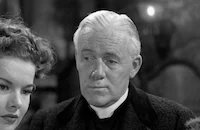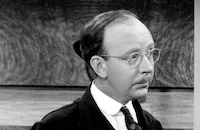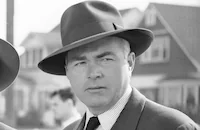Reaching for the Sun
Cast & Crew
William A. Wellman
Joel Mccrea
Ellen Drew
Eddie Bracken
Albert Dekker
Billy Gilbert
Film Details
Technical Specs

Synopsis
Russ Eliot, a clam digger living in the northern backwoods, goes to Detroit hoping to earn enough money to buy an outboard motor for his rowboat and thus improve his business. While standing in the employment line at Crane Motor Co., an automobile manufacturing plant, Russ buys Benny Hogan a cup of coffee and apple pie from the lunch counter. There Russ meets Rita, a tough-talking waitress who works at night as a taxi-dancer. Although Rita thinks Russ's backcountry naïveté is a put-on, as a favor, she nonetheless stows his blanket behind the counter. Russ creates a fracas in the employment line and when a brawl ensues, he and Benny sneak through and are among the ten men hired to work on the assembly line. Russ later earns an enemy in Herman, a big bully who picks a fight with him after getting the wrong idea when he hears that Rita has Russ's blanket at her house. Rita and Russ fall in love and marry, then move to a house in an industrial area, along with Benny, who is their boarder. From the very start, Rita does not share Russ's enthusiasm for returning to the north woods, and his outboard motor becomes a source of contention between them. The discord grows after they have a baby boy and the factory closes down. Finally, with only two dollars left, Rita insists that Russ sell his outboard motor, which he has almost finished paying off. Months pass and with the arrival of spring, Benny and Russ are still unemployed. Russ asks Rita to return to the woods with him where they can make their own living, but Rita insists on remaining in Detroit and urges Russ to give up his dream. They are saved when the factory reopens and Russ is hired to work the hot steel manipulator, a huge machine that works in tandem with the crane operated by Herman. When Russ gets a raise, he and Benny get drunk and buy another outboard motor. This is the last straw for Rita and she leaves Russ. Three days later Russ rises to the bait when Herman flaunts Rita's handkerchief in front of him. Benny stops them from fighting, but later, inside the plant, Herman sends a flaming bundle of steel toward Russ. Russ avoids the steel, which is sent crashing, but then Herman, who is operating the crane, tips Russ's machine over. Russ is pinned and loses his left leg. At the hospital, Russ pretends that he still has his leg when Rita visits him and sends her away. When she learns the truth, however, she rushes to his side. The reunited couple moves to the northern backwoods. Everyone enjoys the new lifestyle except for Benny, who decides to return to the hustle and bustle of the city, and as he departs, the family sails off in their motorized boat onto the lake.

Director

William A. Wellman
Cast

Joel Mccrea

Ellen Drew

Eddie Bracken

Albert Dekker

Billy Gilbert
Bodil Ann Rosing

James Burke

Charles D. Brown
Michael Duggan

Regis Toomey

Hobart Cavanaugh
Charles Williams

Nella Walker

Warren Hymer
Billy Bletcher
Anna Demetrio

Eily Malyon
June Aileen Hedin
Jane Isbell

Gordon Jones

James Flavin
Larry Lawson
C. L. Sherwood
Syd Saylor
Bobby Barber
Bob E. Perry
Foy Van Dolsen
John Kelly
Auguste Tollaire
Douglas Gordon
Michael Morris
Gerald Pierce
Marshall Ruth
Crew
John Coonan
Hans Dreier
Farciot Edouart
Earl Hedrick
William Lebaron
William C. Mellor
Harry Mills
Walter Oberst
W. L. River
Thomas Scott
William A. Wellman
Dewey Wrigley
Victor Young
Joseph C. Youngerman

Film Details
Technical Specs

Articles
Ellen Drew, 1914-2003
She was born Esther Loretta "Terry" Ray on November 23, 1914, in Kansas City, Missouri. The daughter of a barber, her family moved to Chicago when she was still an infant and she lived a very quiet childhood far removed from the glamour of Hollywood. She was encouraged by some friends to enter a beauty contest when she was just 17. After winning, she tried her luck in Hollywood, but found that they were no immediate offers for her particular talents.
She eventually took a waitressing job at C.C. Brown's, a famed Hollywood Boulevard soda fountain, and had virtually abandoned her dreams as a starlet when William Demarest, a popular actor's agent and well-known character actor, spotted her. Demarest arranged a screen test for her at Paramount, and she was promptly placed under contract for $50 a week.
For the first few years, (1936-38), Drew got only bit parts, and was often uncredited. When she finally got prominent billing in the Bing Crosby musical Sing You Sinners (1938), she decided to change her name, from Terry Ray to Ellen Drew. She earned her first major role in Frank Lloyd's If I Were King (1938) opposite Ronald Colman, yet for the most part of her career, rarely rose above "B" material and second leads. Still, she had some fine exceptions: Preston Sturges' enchanting comedy Christmas in July (1940), with Dick Powell; Tay Garnett's lighthearted war romp My Favorite Spy (1942) co-starring Kay Kyser; Julien Duvivier's taut The Imposter (1944), holding her own with a brooding Jean Gabin; and Mark Robson's chilling low-budget chiller Isle of the Dead (1945) opposite Boris Karloff. Drew made some notable television appearances in the late '50s including Perry Mason and The Barbara Stanwyck Show, before retiring from the entertainment industry. She is survived by her son David; five grandchildren; and five great-grandchildren.
by Michael T. Toole

Ellen Drew, 1914-2003
Quotes
Trivia
Notes
A Hollywood Reporter news item noted that preview audiences were so delighted by Eddie Bracken's comedic performance in this film that the main title billing was reshot to include Bracken as a co-star with Joel McCrea and Ellen Drew. According to a news item in Hollywood Reporter, Barbara Stanwyck was originally cast as "Rita," but withdrew to recuperate from an eye operation. Reviews noted that the film strayed from the original novel's serious theme of "labor conflict" and "man against machine." Some scenes were shot on location at Lake Arrowhead, CA.
The factory scenes were shot at the Packard Motor Car Company in Detroit, MI, according to modern sources, which also indicate that writer Robert Carson, a longtime collaborator of director William Wellman, and author Wessel Smitter were involved in pre-production on this film, but then were released from the project. Modern sources add the following information about the production: Transparencies for the scene of the machinery fight were shot by A. Finkl and Sons Company of Chicago, IL; and another scene was shot at the Arturo Ranch near Malibu Lake, CA. Modern sources also note that photographs of director William Wellman's own children appear on the pamphlets from the parenting course in the film.














